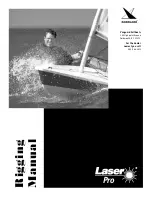
5-4
Section 5 • Care & Maintenance
R
170 Montauk
Remove any mold release wax that may be present
using fiberglass surface prep solvent and a scrub
pad. Scrub only a few square feet at a time. Flush
with fresh water. If the water beads up or separates,
continue scrubbing the surface. When the water
sheets off, the wax contaminate has been removed.
After the dewaxing is complete, application of a
primer coat is recommended. Pay close attention
to scratches, nicks and dings in the surface. If
necessary, fill any repair areas with a watertight
epoxy filler. After filler is cured, sand with 80 grit
paper until smooth. Remove the sanding residue
using a fiberglass solvent wash.
The paint can be applied after sanding and cleaning
is complete. Follow the paint manufacturer’s
recommendations for application.
Bottom
Painting a Pre-Painted Hull
!
WARNING
Bottom paint is designed to resist algae growth
which means it has chemicals embedded in
the paint that are harmful if ingested. Take all
necessary precautions required before painting
or repainting your boat’s hull.
NOTICE
Masking tape is NOT recommended for the types
of paint you will be using.
If the hull bottom is already painted, you must be
sure to test the paint’s adhesion to the already painted
surface. If the paints are incompatible, the new paint
will not adhere to the hull bottom or the paint will
“lift
” the old paint.
NEVER
apply paint without first
preparing the old painted surface following the paint
manufacturer’s recommendations.
Follow the paint manufacturer’s recommendation for
applying the paint. Humidity and weather will play
a role in how and when the paint is applied. Several
thin layers are better than one thick layer.
To determine the waterline, you will need to place the
boat in water with a full load of fuel and gear. Mark
the waterline and measure above the marked line
1 to 3 inches for placement of the tape line.
Make sure that there is enough paint left to cover
areas that were not accessible, (slings, jack stands
etc.) and paint accordingly. Follow the
paint
manufacturer’s recommendation for do’s and dont’s
after the painting is complete.
Rubrail Care
The rubrail on your boat is constructed of an injected
high density
PVC vinyl
material which laboratory
tests have proven to be highly resistant to staining,
fading and cracking.
As resilient as this material is, you still need to follow
some basic maintenance precautions.
General maintenance requires a thorough cleaning
with mild soap & water.
DO NOT
use any cleaning
agents which contain chemicals.
Although the outer shell is tough and durable, there
is a chance that it can be breached. Use care when
docking or exposing the rubrail to conditions which
may cause damage such as docking against heavily
barnacle-encrusted pilings.
Some tears (cleanly sliced) can be repaired with a
“Super Glue” type product.
Thoroughly clean and dry the affected area. Apply
glue and hold the surfaces together.
Areas which have been torn or are affected by heavy
abrasion will have to have the damaged section
replaced. Please see your Boston Whaler
®
dealer for
this type of repair.
Cleaning Fiberglass & Non-Skid
To protect your deck and non-skid areas from the
deteriorating affects of the sun, oxidation, water
spots and pollution, use a good quality “fiberglass
and non-skid deck” wax every two to three months.
When applied to your deck and non-skid areas, as
recommended by the manufacturer, the wax forms a
protective non-slick surface which will keep debris
from sticking. Dirt, soot, bird droppings, and even
fish blood will rinse right off.
Summary of Contents for 170 Montauk
Page 1: ......
Page 43: ...1 22 170 Montauk Section 1 Safety R THIS PAGE INTENTIONALLY LEFT BLANK ...
Page 67: ...2 24 170 Montauk Section 2 General Information R THIS PAGE INTENTIONALLY LEFT BLANK ...
Page 91: ...4 12 170 Montauk Section 4 Electrical System R THIS PAGE INTENTIONALLY LEFT BLANK ...
Page 102: ...5 11 Section 5 Care Maintenance R 170 Montauk Reinforcement Location Diagram ...









































